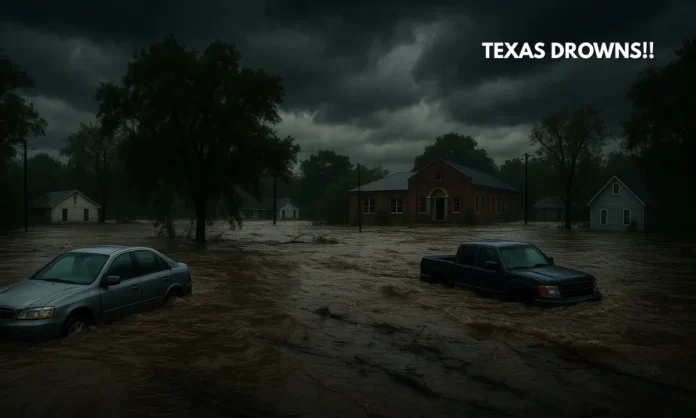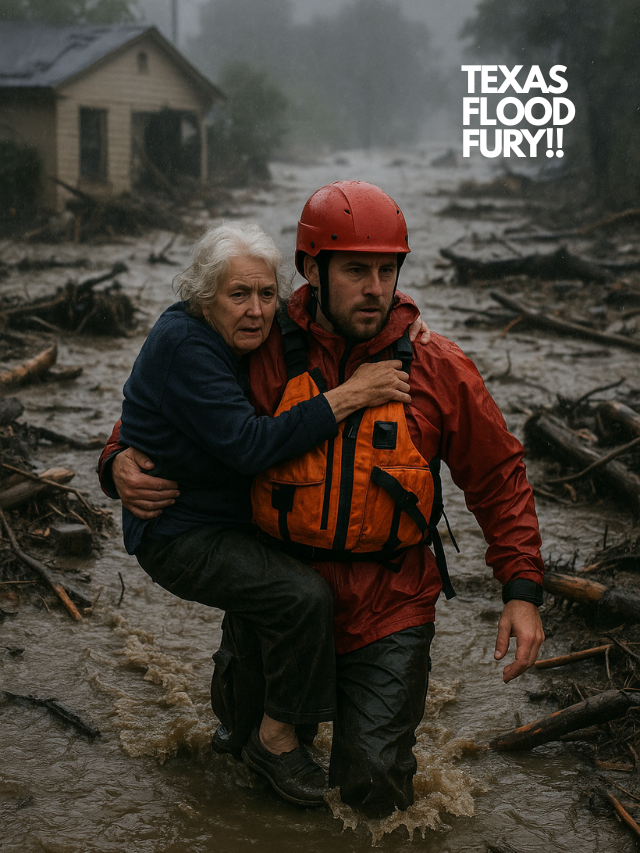Summary
- Torrential July 4th floods kill 109 across Texas; Kerr County records 94 deaths alone.
- Over 160 still missing, many from a youth camp swept away by the Guadalupe River.
- Rescue operations face delays and scrutiny amid funding cuts, climate-driven risks, and NWS staffing gaps.
Kerr County’s Deadliest Hour: How a Quiet Camp Turned into a Disaster Zone
As fireworks lit up the skies across America on July 4, 2025, a different kind of explosion unfolded in Texas — one of nature’s fury. In the heart of “Flash Flood Alley,” Kerr County bore the brunt of a catastrophic flash flood that has already claimed 109 lives statewide and left over 160 missing. Entire communities were submerged in silence and sludge as rivers burst their banks and swept through homes, schools, and camps in the dead of night.
Governor Greg Abbott confirmed the harrowing numbers on Tuesday, with 161 people still unaccounted for in Kerr County alone. The situation remains fluid, with rising fears that the death toll could increase as search operations — hampered by mud, debris, and more rain — continue. Particularly devastating was the flood’s impact on a youth summer camp by the Guadalupe River, where at least 27 girls and counselors were caught in the deluge.
This article explores the three-pronged crisis: the human cost of delayed emergency response, the role of climatic extremes in magnifying flash flood disasters, and growing questions around federal preparedness under the Trump administration. At the core is a haunting question: Could more lives have been saved?
119 confirmed dead and 176 still missing after historic flooding in Texas – @KennedyRHayes on @foxweather from Kerrville, Texas pic.twitter.com/oNW5XE5XG6
— Fox News MMR (@FoxNewsMMR) July 9, 2025
Swept Away: The Human Toll of a Midnight Flash Flood
- Kerr County alone saw 94 of the 109 confirmed deaths.
- 27 campers and staff were swept away; at least 6 remain missing.
- Hundreds of homes destroyed; survivors report no prior warnings.
By 9 a.m. on July 5, rescue helicopters hovered over Hunt, Texas — the epicenter of devastation — trying to spot survivors amid submerged vehicles and collapsed bridges. Among the casualties were families, elderly residents, and children asleep in summer camps. Javier Torres, 24, unearthed the body of his grandfather before finding two more children swept ashore by the river. He continues to dig for his missing grandmother.
Local rescue officials from the Texas Game Wardens and National Guard described the scene as “treacherous.” Large debris piles, thick mud, and unstable structures slowed search-and-recovery missions to a crawl. With five days of relentless effort behind them, responders admitted that finding survivors was growing increasingly unlikely.
Yet, despite the scale of destruction, many in Kerrville and surrounding towns said there was no formal warning — no blaring sirens, no emergency messages. For those sleeping near the Guadalupe River, the only signal was the sound of their walls collapsing.
Climate Meets Incompetence: Did Drought, Cuts, and Shortages Magnify the Tragedy?
- Texas endured extreme droughts before the flood, worsening runoff impacts.
- NWS staffing shortages hindered early warnings, experts say.
- Trump’s government faces heat over emergency budget slashes.
Climate experts have long warned about “flash flood amplification” in Central Texas — a region historically susceptible to abrupt water surges due to topography. What worsened the 2025 floods, according to researchers from Climate Central, was the region’s exceptional drought. “Dry soil can’t absorb rainfall quickly, so the water just runs off,” said weather scientist Shel Winkley.
The torrential rainfall over a baked landscape turned roads into rivers and caused instantaneous surges. The Rio Ruidoso in neighboring New Mexico reportedly crested 20 feet above normal, demonstrating the breadth of the storm’s impact.
But environmental factors weren’t the only culprits. Experts and civil society groups are questioning whether funding cuts under President Trump played a part in the slow response. The National Weather Service — already grappling with staffing shortages — failed to issue region-wide flash flood alerts until it was too late.
Tom Di Liberto of Climate Central noted, “You can’t replace that kind of human forecasting experience overnight.” Meanwhile, Governor Abbott acknowledged the gaps but deflected accountability during a tense press conference.
The Politics of Rescue: Helicopters, Delays, and a Presidential Visit
- President Trump to visit Kerr County on July 11 with First Lady Melania.
- Critics accuse administration of late deployment and emergency unpreparedness.
- Political optics collide with local anguish as residents demand accountability.
As bodies continue to be pulled from the debris, political theatre is playing out in Washington and Texas. President Trump, speaking ahead of his scheduled visit on July 11, praised the helicopter crews flown in from other states, calling them “real pros.” Yet the praise rings hollow for many on the ground who question why those helicopters arrived after the waters had already swallowed entire communities.
Ben Baker, a field official with the Texas Game Wardens, was asked directly about the delay in response. His answer — “Right now, this team is focused on bringing people home” — was a deflection that only fueled further anger.
At the center of criticism is not just Trump’s slow-footed federal response, but years of funding cuts to emergency preparedness programs and environmental research. Critics point out that early warning systems in the region were under-resourced, and public drills had not been conducted in years.
Meanwhile, survivors wait. Some, like Torres, are still digging with their own hands. Others are camping out in temporary shelters, staring at mud-covered photographs of what used to be their homes.
Broken Levees, Broken Trust: What the Texas Floods Reveal About America’s Crisis Readiness
The Kerr County floods of July 2025 have exposed a tragic intersection of natural disaster and systemic failure. Geography played its part. But climate volatility, political negligence, and infrastructure decay made this crisis deadlier than it had to be.
From underfunded federal agencies to local governments stretched thin by reactive policies, the aftermath of the floods serves as a brutal reminder: disaster isn’t just what nature unleashes, but also how unprepared systems allow it to escalate.
As the search for the missing continues and the death toll ticks upward, Texans are not just mourning — they’re demanding a reckoning. Not only for the 109 confirmed dead or the 161 still missing, but for a better way forward.
The question isn’t if another flash flood will come — but whether next time, America will be ready.



